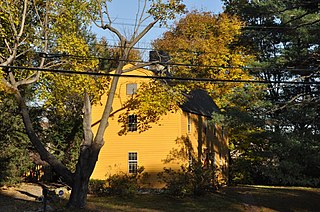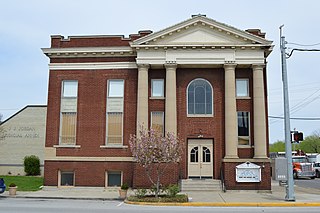
Louisa is a home rule-class city located at the merger of the Levisa and Tug Forks into the Big Sandy River. It is located in Lawrence County, Kentucky, in the United States, and is the seat of its county. The population was 2,467 at the 2010 census and an estimated 2,375 in 2018.

The Battle of Richmond, Kentucky, fought August 29–30, 1862, was one of the most complete Confederate victories in the war by Major General Edmund Kirby Smith against Union major general William "Bull" Nelson's forces, which were defending the town. It was the first major battle in the Kentucky Campaign. The battle took place on and around what is now the grounds of the Blue Grass Army Depot, outside Richmond, Kentucky.

The Levisa Fork is a tributary of the Big Sandy River, approximately 164 miles (264 km) long, in southwestern Virginia and eastern Kentucky in the United States.

The Battle of Middle Creek was an engagement fought January 10, 1862, in Eastern Kentucky during the American Civil War.

The National Register of Historic Places in the United States is a register including buildings, sites, structures, districts, and objects. The Register automatically includes all National Historic Landmarks as well as all historic areas administered by the U.S. National Park Service. Since its introduction in 1966, more than 90,000 separate listings have been added to the register.

This is a list of properties and historic districts in Iowa that are listed on the National Register of Historic Places. There are listings in all of Iowa's 99 counties, adding up to over 2,300 total.

Ward Hall is a Greek Revival antebellum plantation mansion located in Georgetown, Kentucky. The main house covers 12,000 square feet (1,100 m2), with 27-foot (8.2 m) high Corinthian fluted columns.

The Daniel Carter Beard Boyhood Home is a National Historic Landmark located in the Riverside Drive Historic District of Covington, Kentucky, overlooking the Licking River, across the Ohio River from Cincinnati, Ohio. The two-and-one-half story brick domicile, built in 1821 and one of the two oldest buildings in Kenton County, Kentucky, is the boyhood home of Daniel Carter Beard, a founder of the Boy Scouts of America. He was their National Scout Commissioner from its 1910 founding to his death in 1941.

The King Iron Bridge & Manufacturing Company was a late-19th-century bridge building company located in Cleveland, Ohio. It was founded by Zenas King (1818–1892) in 1858 and subsequently managed by his sons, James A. King and Harry W. King and then his grandson, Norman C. King, until the mid-1920s. Many of the bridges built by the company were used during America's expansion west in the late 19th century and early 20th century, and some of these bridges are still standing today.

Wendover, also known as Frontier Nursing Service or Big House, is a historic house and former medical care facility near Hyden, Kentucky. Built in 1925, it is notable for its association with the American effort to professionalize midwifery, led by Mary Breckinridge (1881-1965). It was headquarters of the Frontier Nursing Service, an organization which continues today. Wendover was named a U.S. National Historic Landmark in 1991 for this role. It now serves as a bed and breakfast inn and retreat operated by the Service's success, Frontier Nursing University.

The Capt. William Green House is a historic colonial house at 391 Vernon Street in Wakefield, Massachusetts. It is one of Wakefield's oldest surviving buildings. The house was listed on the National Register of Historic Places as part of two separate listings. In 1989 it was listed under the name "Capt. William Green House", and in 1990 it was listed under the name "Green House".
Guyandotte is a historic neighborhood in the city of Huntington, West Virginia, that previously existed as a separate town before annexation was completed by the latter. The neighborhood is home to many historic properties, and was first settled by natives of France at the end of the eighteenth century. Guyandotte was already a thriving town when the state of West Virginia was formed from part of Virginia. Located at the confluence of the Guyandotte River and the Ohio River, it was already a regional trade center with several industries of its own when the Chesapeake and Ohio Railway (C&O) reached its western terminus nearby just across the Guyandotte River in 1873. This event was soon followed by the formation and quick development of the present city of Huntington which was named in honor of the C&O Railway's founder and then principal owner Collis P. Huntington.

The Captain Avery Museum is a historic home and museum at Shady Side, Anne Arundel County, Maryland, United States. It is a two-story frame building, located on a 0.75-acre (3,000 m2) rectangular lot. The house overlooks the West River and Chesapeake Bay. The two-story historic structure originally was the residence of the Chesapeake Bay waterman, Capt. Salem Avery, and was constructed about 1860. It was expanded in the nineteenth century and further expanded in the 1920s by the National Masonic Fishing and Country Club. The property consists of the main house with additions, three sheds formerly used as bath houses, and a modern boathouse built in 1993 that features the Edna Florence, a locally-built 1937 Chesapeake Bay deadrise workboat.

The First United Methodist Church of Louisa, Kentucky is a historic church built in c.1850. It is located at 204 W. Main Street in Louisa. It was added to the National Register of Historic Places in 1984.

Louisa United Methodist Church is a historic church at Main Cross and Madison Streets in Louisa, Kentucky. It was built in 1916 and added to the National Register of Historic Places in 1988.

Byrnside-Beirne-Johnson House, also known as "Willowbrook," is a historic home located near Union, Monroe County, West Virginia. The house began as a pioneer log fort built by six families in 1770. After 1855, it was enlarged to a large 2½-story, five-bay, "T"-shaped dwelling with a two-story rear wing. It is covered with board-and-batten siding in the Gothic Revival style. The front features a two-story gable end porch built about 1900. Also on the property is a contributing smokehouse.

The Chesapeake and Ohio Passenger Depot in Pikeville, Kentucky was built by the Chesapeake and Ohio Railway in 1923. The station along with a small baggage depot nearby were listed on the National Register of Historic Places on April 23, 1987.

The Atkins–Carter House, at 314 E. Madison St. in Louisa in Lawrence County, Kentucky, was built in 1890. It was listed on the National Register of Historic Places in 1988.

The Big Sandy Milling Company, in Louisa, Kentucky was listed on the National Register of Historic Places in 1988.



















